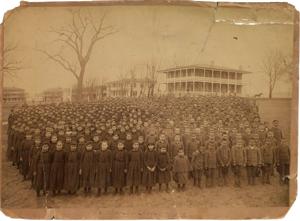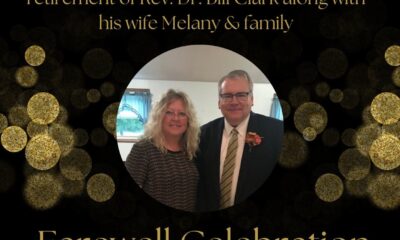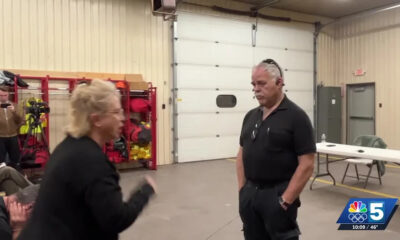World
Native American Students’ Remains Repatriated from PA Cemetery

The remains of 17 students who once attended the Carlisle Indian Industrial School have been repatriated after decades of efforts by their tribes. Among them were Matavito Horse, a Cheyenne boy, and Leah Road Traveler, an Arapaho girl, both taken to the school in October 1879 as part of a U.S. government initiative to erase Native American identities. Their remains, along with those of 15 other children, were exhumed from a cemetery in Pennsylvania and reburied last month in a ceremony at a tribal cemetery in Concho, Oklahoma.
The Cheyenne and Arapaho Tribes of Oklahoma led the repatriation of the 16 children, which included burial rites described by tribal officials as a significant step towards justice and healing for families affected by the boarding school era. A 17th student, Wallace Perryman, was returned to the Seminole Nation of Oklahoma. Perryman’s family requested privacy and did not provide public comments about the repatriation.
Historical Context and Experiences
The Carlisle Indian Industrial School, operational from 1879 to 1918, was part of a broader effort to assimilate Native American children into European-American culture. Records show that approximately 7,800 students from more than 100 tribes attended the school, often under harsh conditions. The children were stripped of their cultural identities, with their long hair cut and military-style uniforms issued. They were required to speak English and participated in manual labor in addition to academic classes.
Chronicling the experiences of these students, historians have noted that many faced tragic fates. Matavito Horse became the first known victim of typhoid fever at Carlisle, while Leah’s cause of death remains unclear. Other students died from tuberculosis, spinal meningitis, and typhoid fever. The documentation surrounding their lives is often incomplete, with many records containing inaccuracies regarding names and ages.
According to Preston McBride, a historian at Pomona College, “Sometimes the only evidence of a child’s existence is a scrap of paper with a hastily scribbled note.” This lack of information complicates efforts to identify and honor all students who attended the school.
The Repatriation Process
Since repatriations began in 2017, a total of 58 students have been returned to their tribes. The process is both complicated and costly, as it often requires significant funding and coordination among tribal nations, the U.S. Army, and other entities. For many tribes, securing the return of their ancestors is a moral imperative. Samuel Torres of the National Native American Boarding School Healing Coalition emphasized the need for governmental support in these efforts.
While some families and tribes have been successful in locating their ancestors, others face challenges. Poor documentation has led to instances where expected remains do not match those found in graves. For example, a grave thought to hold a young boy from the Wichita tribe instead contained the remains of another individual.
Norene Starr, a projects coordinator for the Cheyenne and Arapaho Tribes, described the discrepancies as a “federal atrocity,” highlighting the ongoing struggle to accurately identify and honor those who were lost. She is currently working with forensic experts to correct these errors.
The complex legacy of the Carlisle Indian Industrial School is still felt today. In recognition of the historical trauma inflicted upon Native American communities, President Joe Biden issued an apology last year, acknowledging the suffering caused by policies aimed at cultural erasure.
As the repatriation of these children continues, many tribal nations are left to navigate the emotional landscape of loss and healing while advocating for the return of their ancestors. The recent burial services, attended by hundreds, reflect a collective memory that is both painful and essential for the ongoing journey toward justice and reconciliation.
-

 World4 months ago
World4 months agoScientists Unearth Ancient Antarctic Ice to Unlock Climate Secrets
-

 Entertainment4 months ago
Entertainment4 months agoTrump and McCormick to Announce $70 Billion Energy Investments
-

 Lifestyle4 months ago
Lifestyle4 months agoTransLink Launches Food Truck Program to Boost Revenue in Vancouver
-

 Science4 months ago
Science4 months agoFour Astronauts Return to Earth After International Space Station Mission
-

 Technology2 months ago
Technology2 months agoApple Notes Enhances Functionality with Markdown Support in macOS 26
-

 Top Stories4 weeks ago
Top Stories4 weeks agoUrgent Update: Fatal Crash on Highway 99 Claims Life of Pitt Meadows Man
-

 Sports4 months ago
Sports4 months agoSearch Underway for Missing Hunter Amid Hokkaido Bear Emergency
-

 Politics3 months ago
Politics3 months agoUkrainian Tennis Star Elina Svitolina Faces Death Threats Online
-

 Politics4 months ago
Politics4 months agoCarney Engages First Nations Leaders at Development Law Summit
-

 Technology4 months ago
Technology4 months agoFrosthaven Launches Early Access on July 31, 2025
-

 Top Stories2 weeks ago
Top Stories2 weeks agoFamily Remembers Beverley Rowbotham 25 Years After Murder
-

 Top Stories7 days ago
Top Stories7 days agoBlake Snell’s Frustration Ignites Toronto Blue Jays Fan Fury





















